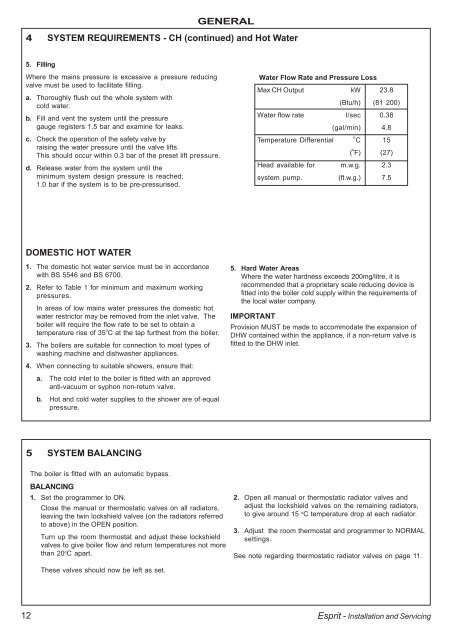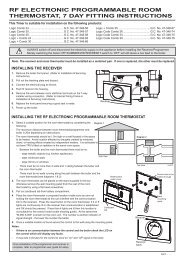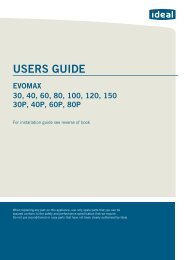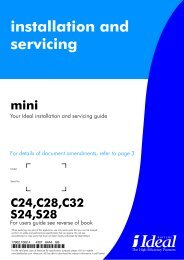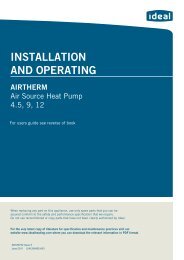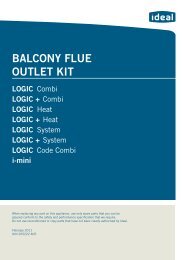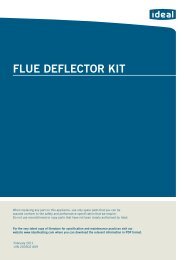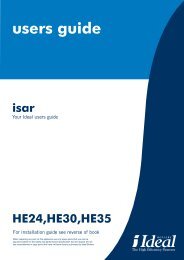iDEAl EsPRit - Ideal Heating
iDEAl EsPRit - Ideal Heating
iDEAl EsPRit - Ideal Heating
You also want an ePaper? Increase the reach of your titles
YUMPU automatically turns print PDFs into web optimized ePapers that Google loves.
GENERAL<br />
4 SYSTEM REQUIREMENTS - CH (continued) and Hot Water<br />
5. Filling<br />
Where the mains pressure is excessive a pressure reducing<br />
valve must be used to facilitate filling.<br />
a. Thoroughly flush out the whole system with<br />
cold water.<br />
b. Fill and vent the system until the pressure<br />
gauge registers 1.5 bar and examine for leaks.<br />
c. Check the operation of the safety valve by<br />
raising the water pressure until the valve lifts.<br />
This should occur within 0.3 bar of the preset lift pressure.<br />
d. Release water from the system until the<br />
minimum system design pressure is reached;<br />
1.0 bar if the system is to be pre-pressurised.<br />
DOMESTIC HOT WATER<br />
1. The domestic hot water service must be in accordance<br />
with BS 5546 and BS 6700.<br />
2. Refer to Table 1 for minimum and maximum working<br />
pressures.<br />
In areas of low mains water pressures the domestic hot<br />
water restrictor may be removed from the inlet valve. The<br />
boiler will require the flow rate to be set to obtain a<br />
temperature rise of 35 o C at the tap furthest from the boiler.<br />
3. The boilers are suitable for connection to most types of<br />
washing machine and dishwasher appliances.<br />
4. When connecting to suitable showers, ensure that:<br />
a. The cold inlet to the boiler is fitted with an approved<br />
anti-vacuum or syphon non-return valve.<br />
b. Hot and cold water supplies to the shower are of equal<br />
pressure.<br />
5 SYSTEM BALANCING<br />
The boiler is fitted with an automatic bypass.<br />
BALANCING<br />
1. Set the programmer to ON.<br />
Close the manual or thermostatic valves on all radiators,<br />
leaving the twin lockshield valves (on the radiators referred<br />
to above) in the OPEN position.<br />
Turn up the room thermostat and adjust these lockshield<br />
valves to give boiler flow and return temperatures not more<br />
than 20oC apart.<br />
These valves should now be left as set.<br />
Water Flow Rate and Pressure Loss<br />
Max CH Output kW 23.8<br />
(Btu/h) (81 200)<br />
Water flow rate l/sec 0.38<br />
(gal/min) 4.8<br />
Temperature Differential<br />
o<br />
C 15<br />
( o F) (27)<br />
Head available for m.w.g. 2.3<br />
system pump. (ft.w.g.) 7.5<br />
5. Hard Water Areas<br />
Where the water hardness exceeds 200mg/litre, it is<br />
recommended that a proprietary scale reducing device is<br />
fitted into the boiler cold supply within the requirements of<br />
the local water company.<br />
IMPORTANT<br />
Provision MUST be made to accommodate the expansion of<br />
DHW contained within the appliance, if a non-return valve is<br />
fitted to the DHW inlet.<br />
2. Open all manual or thermostatic radiator valves and<br />
adjust the lockshield valves on the remaining radiators,<br />
to give around 15 o C temperature drop at each radiator.<br />
3. Adjust the room thermostat and programmer to NORMAL<br />
settings.<br />
See note regarding thermostatic radiator valves on page 11.<br />
12 Esprit - Installation and Servicing


